[English] 日本語
 Yorodumi
Yorodumi- PDB-5nni: Dimer structure of Sortilin ectodomain crystal form 2, 3.2 Angstrom -
+ Open data
Open data
- Basic information
Basic information
| Entry | Database: PDB / ID: 5nni | |||||||||
|---|---|---|---|---|---|---|---|---|---|---|
| Title | Dimer structure of Sortilin ectodomain crystal form 2, 3.2 Angstrom | |||||||||
 Components Components | Sortilin | |||||||||
 Keywords Keywords | TRANSPORT PROTEIN / VPS10 domain / transport receptor / internalization / 10 bladed beta-propeller | |||||||||
| Function / homology |  Function and homology information Function and homology informationneurotensin receptor activity, non-G protein-coupled / Golgi to lysosome transport / plasma membrane to endosome transport / myotube differentiation / nerve growth factor receptor activity / cerebellar climbing fiber to Purkinje cell synapse / maintenance of synapse structure / retromer complex binding / Golgi to endosome transport / endosome transport via multivesicular body sorting pathway ...neurotensin receptor activity, non-G protein-coupled / Golgi to lysosome transport / plasma membrane to endosome transport / myotube differentiation / nerve growth factor receptor activity / cerebellar climbing fiber to Purkinje cell synapse / maintenance of synapse structure / retromer complex binding / Golgi to endosome transport / endosome transport via multivesicular body sorting pathway / Golgi Associated Vesicle Biogenesis / nerve growth factor binding / vesicle organization / protein targeting to lysosome / trans-Golgi network transport vesicle / Golgi cisterna membrane / endosome to lysosome transport / negative regulation of fat cell differentiation / neurotrophin TRK receptor signaling pathway / D-glucose import / extrinsic apoptotic signaling pathway via death domain receptors / neuropeptide signaling pathway / clathrin-coated pit / ossification / cytoplasmic vesicle membrane / response to insulin / endocytosis / regulation of gene expression / nuclear membrane / early endosome / lysosome / endosome membrane / lysosomal membrane / endoplasmic reticulum membrane / perinuclear region of cytoplasm / enzyme binding / cell surface / Golgi apparatus / plasma membrane / cytosol Similarity search - Function | |||||||||
| Biological species |  | |||||||||
| Method |  X-RAY DIFFRACTION / X-RAY DIFFRACTION /  SYNCHROTRON / SYNCHROTRON /  MOLECULAR REPLACEMENT / Resolution: 3.21 Å MOLECULAR REPLACEMENT / Resolution: 3.21 Å | |||||||||
 Authors Authors | Leloup, N.O.L. / Janssen, B.J.C. | |||||||||
| Funding support |  Netherlands, 2items Netherlands, 2items
| |||||||||
 Citation Citation |  Journal: Nat Commun / Year: 2017 Journal: Nat Commun / Year: 2017Title: Low pH-induced conformational change and dimerization of sortilin triggers endocytosed ligand release. Authors: Nadia Leloup / Philip Lössl / Dimphna H Meijer / Martha Brennich / Albert J R Heck / Dominique M E Thies-Weesie / Bert J C Janssen /   Abstract: Low pH-induced ligand release and receptor recycling are important steps for endocytosis. The transmembrane protein sortilin, a β-propeller containing endocytosis receptor, internalizes a diverse ...Low pH-induced ligand release and receptor recycling are important steps for endocytosis. The transmembrane protein sortilin, a β-propeller containing endocytosis receptor, internalizes a diverse set of ligands with roles in cell differentiation and homeostasis. The molecular mechanisms of pH-mediated ligand release and sortilin recycling are unresolved. Here we present crystal structures that show the sortilin luminal segment (s-sortilin) undergoes a conformational change and dimerizes at low pH. The conformational change, within all three sortilin luminal domains, provides an altered surface and the dimers sterically shield a large interface while bringing the two s-sortilin C-termini into close proximity. Biophysical and cell-based assays show that members of two different ligand families, (pro)neurotrophins and neurotensin, preferentially bind the sortilin monomer. This indicates that sortilin dimerization and conformational change discharges ligands and triggers recycling. More generally, this work may reveal a double mechanism for low pH-induced ligand release by endocytosis receptors. | |||||||||
| History |
|
- Structure visualization
Structure visualization
| Structure viewer | Molecule:  Molmil Molmil Jmol/JSmol Jmol/JSmol |
|---|
- Downloads & links
Downloads & links
- Download
Download
| PDBx/mmCIF format |  5nni.cif.gz 5nni.cif.gz | 539 KB | Display |  PDBx/mmCIF format PDBx/mmCIF format |
|---|---|---|---|---|
| PDB format |  pdb5nni.ent.gz pdb5nni.ent.gz | 448.2 KB | Display |  PDB format PDB format |
| PDBx/mmJSON format |  5nni.json.gz 5nni.json.gz | Tree view |  PDBx/mmJSON format PDBx/mmJSON format | |
| Others |  Other downloads Other downloads |
-Validation report
| Summary document |  5nni_validation.pdf.gz 5nni_validation.pdf.gz | 1.7 MB | Display |  wwPDB validaton report wwPDB validaton report |
|---|---|---|---|---|
| Full document |  5nni_full_validation.pdf.gz 5nni_full_validation.pdf.gz | 1.7 MB | Display | |
| Data in XML |  5nni_validation.xml.gz 5nni_validation.xml.gz | 52.1 KB | Display | |
| Data in CIF |  5nni_validation.cif.gz 5nni_validation.cif.gz | 65.3 KB | Display | |
| Arichive directory |  https://data.pdbj.org/pub/pdb/validation_reports/nn/5nni https://data.pdbj.org/pub/pdb/validation_reports/nn/5nni ftp://data.pdbj.org/pub/pdb/validation_reports/nn/5nni ftp://data.pdbj.org/pub/pdb/validation_reports/nn/5nni | HTTPS FTP |
-Related structure data
| Related structure data |  5nmrC  5nmtSC  5nnjC S: Starting model for refinement C: citing same article ( |
|---|---|
| Similar structure data |
- Links
Links
- Assembly
Assembly
| Deposited unit | 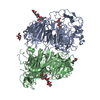
| ||||||||
|---|---|---|---|---|---|---|---|---|---|
| 1 |
| ||||||||
| Unit cell |
|
- Components
Components
| #1: Protein | Mass: 81364.078 Da / Num. of mol.: 2 Source method: isolated from a genetically manipulated source Source: (gene. exp.)   Homo sapiens (human) / References: UniProt: Q6PHU5 Homo sapiens (human) / References: UniProt: Q6PHU5#2: Polysaccharide | Source method: isolated from a genetically manipulated source #3: Polysaccharide | 2-acetamido-2-deoxy-beta-D-glucopyranose-(1-4)-2-acetamido-2-deoxy-beta-D-glucopyranose | Source method: isolated from a genetically manipulated source #4: Sugar | Has protein modification | Y | |
|---|
-Experimental details
-Experiment
| Experiment | Method:  X-RAY DIFFRACTION / Number of used crystals: 1 X-RAY DIFFRACTION / Number of used crystals: 1 |
|---|
- Sample preparation
Sample preparation
| Crystal | Density Matthews: 2.48 Å3/Da / Density % sol: 50.46 % |
|---|---|
| Crystal grow | Temperature: 291 K / Method: vapor diffusion, sitting drop / pH: 5 Details: 0.2 M NH4Cl, 1 mM CaCl2 and 20% PEG 3350 (w/v), pH 5.0 |
-Data collection
| Diffraction | Mean temperature: 100 K |
|---|---|
| Diffraction source | Source:  SYNCHROTRON / Site: SYNCHROTRON / Site:  SLS SLS  / Beamline: X06SA / Wavelength: 0.99998 Å / Beamline: X06SA / Wavelength: 0.99998 Å |
| Detector | Type: DECTRIS PILATUS3 6M / Detector: PIXEL / Date: Aug 29, 2014 |
| Radiation | Protocol: SINGLE WAVELENGTH / Monochromatic (M) / Laue (L): M / Scattering type: x-ray |
| Radiation wavelength | Wavelength: 0.99998 Å / Relative weight: 1 |
| Reflection | Resolution: 3.21→62.2 Å / Num. obs: 27112 / % possible obs: 99.7 % / Redundancy: 6.3 % / CC1/2: 0.997 / Rmerge(I) obs: 0.077 / Rpim(I) all: 0.033 / Net I/σ(I): 14.1 |
| Reflection shell | Resolution: 3.21→3.325 Å / Redundancy: 2 % / Rmerge(I) obs: 0.1578 / Mean I/σ(I) obs: 4.37 / Num. unique obs: 2654 / CC1/2: 0.945 / Rpim(I) all: 0.1578 / % possible all: 99.59 |
- Processing
Processing
| Software |
| |||||||||||||||||||||||||||||||||||||||||||||||||||||||||||||||||||||||||||||||||||||||||||||||||||||||||||||||||||||||||||||
|---|---|---|---|---|---|---|---|---|---|---|---|---|---|---|---|---|---|---|---|---|---|---|---|---|---|---|---|---|---|---|---|---|---|---|---|---|---|---|---|---|---|---|---|---|---|---|---|---|---|---|---|---|---|---|---|---|---|---|---|---|---|---|---|---|---|---|---|---|---|---|---|---|---|---|---|---|---|---|---|---|---|---|---|---|---|---|---|---|---|---|---|---|---|---|---|---|---|---|---|---|---|---|---|---|---|---|---|---|---|---|---|---|---|---|---|---|---|---|---|---|---|---|---|---|---|---|
| Refinement | Method to determine structure:  MOLECULAR REPLACEMENT MOLECULAR REPLACEMENTStarting model: 5NMT Resolution: 3.21→62.195 Å / SU ML: 0.43 / Cross valid method: FREE R-VALUE / σ(F): 1.34 / Phase error: 27.38
| |||||||||||||||||||||||||||||||||||||||||||||||||||||||||||||||||||||||||||||||||||||||||||||||||||||||||||||||||||||||||||||
| Solvent computation | Shrinkage radii: 0.9 Å / VDW probe radii: 1.11 Å | |||||||||||||||||||||||||||||||||||||||||||||||||||||||||||||||||||||||||||||||||||||||||||||||||||||||||||||||||||||||||||||
| Refinement step | Cycle: LAST / Resolution: 3.21→62.195 Å
| |||||||||||||||||||||||||||||||||||||||||||||||||||||||||||||||||||||||||||||||||||||||||||||||||||||||||||||||||||||||||||||
| Refine LS restraints |
| |||||||||||||||||||||||||||||||||||||||||||||||||||||||||||||||||||||||||||||||||||||||||||||||||||||||||||||||||||||||||||||
| LS refinement shell |
| |||||||||||||||||||||||||||||||||||||||||||||||||||||||||||||||||||||||||||||||||||||||||||||||||||||||||||||||||||||||||||||
| Refinement TLS params. | Method: refined / Refine-ID: X-RAY DIFFRACTION
| |||||||||||||||||||||||||||||||||||||||||||||||||||||||||||||||||||||||||||||||||||||||||||||||||||||||||||||||||||||||||||||
| Refinement TLS group |
|
 Movie
Movie Controller
Controller


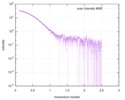
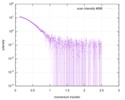


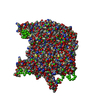
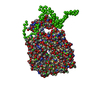
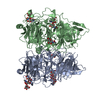
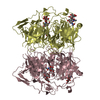
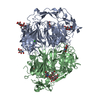




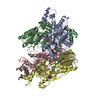
 PDBj
PDBj


